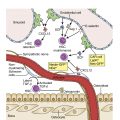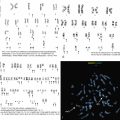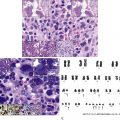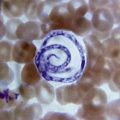General Overview and Incidence
- •
Definition of Hodgkin lymphoma (HL): lymphoid neoplasm affecting lymph nodes; paucity of neoplastic cells with rich inflammatory background
- •
Classic Hodgkin lymphoma (cHL) 90% to 95% of cases
- •
Nodular lymphocyte-predominant Hodgkin lymphoma (NLPHL) 5% to 10% of cases ,
Epidemiology
- •
2.5 to 3 per 100,000 per year with higher incidence in men
- •
In 2014, estimated 204,065 people with HL in the United States
- •
In 2017, estimated 8260 new cases of HL in the United States and 1030 estimated deaths related to HL
- •
Fourth most common type of lymphoma of all non-Hodgkin lymphoma (NHL)
Etiology
- •
Unknown
- •
Epstein-Barr virus (EBV) exposure association in up to 30% of cases
- •
Bimodal distribution with peaks in young adolescents and patients older than 65 years
- •
Human immunodeficiency virus (HIV)/AIDS-associated and family history
Clinical Features
The most common presentation is nontender lymphadenopathy in the neck, in the supraclavicular region, or in the axillae. Mediastinal lymphadenopathy that causes chest pain, dyspnea, or cough is also frequent in these patients and may present as an incidental finding on a chest x-ray. Up to one-third of patients with HL may present with night sweats and unexplained weight loss (defined as >10% of baseline weight). Pel-Ebstein fever, an unexplained fever that remits and relapses over weeks, is characteristic ( Box 11.1 ).
Constitutional: Fever >38 ° C, drenching night sweats, weight loss
Brain: Paraneoplastic syndromes, cerebellar degeneration, limbic encephalitis
Cutaneous: Inflammatory-like erythema nodosum
Lymph nodes: Painless lymphadenopathy, 75% cervical region, then mediastinal, axillary, para-aortic
Liver: Sometimes enlarged
Spleen: Sometimes enlarged
Bone marrow: Pancytopenia, 5% to 8% involved
Kidneys: Nephrotic syndrome
Blood: Thrombocytopenia
Hypercalcemia
Immune hemolytic anemia
Thromboembolic events at risk
In addition to the previously mentioned symptoms, unusual presentations include severe and unexplained itching and pain at an enlarged lymph node after consumption of alcohol. Patients with HIV and AIDS have an increased frequency of HL, in whom it tends to involve extranodal sites and has an aggressive clinical course with poorer prognosis.
A total of 5% to 10% of all HL cases are NLPHL. These occur predominantly in males between 30 and 50 years. Most patients present with localized early stage (stage I–II) lymphadenopathy. Splenic and bone marrow involvement is rare. This particular type of HL is slow growing compared with cHL and has frequent relapses. This subtype can transform into diffuse large B-cell lymphoma (DLBCL) in 3% to 5% of cases.
Diagnostic Studies
Staging
The Ann Arbor staging system is currently used to stage HL in patients with newly diagnosed disease. It is imperative to accurately stage the disease as it has prognostic as well as treatment implications. Positron emission tomography–computed tomography (PET-CT) scanning is the current standard test used to identify involved lymph node groups as well as the bone marrow, although bone marrow biopsy is often performed to confirm bone marrow involvement ( Table 11.1 ; Boxes 11.2–11.5 ; Figs. 11.1 and 11.2 ).
| Stage | Extent of Disease |
|---|---|
| I | Involvement of a single lymph node region or lymphoid structure |
| II | Involvement of ≥2 lymph node regions on one side of the diaphragm |
| III | Involvement of ≥2 lymph node regions on both sides of diaphragm |
| IV | Disseminated involvement of a deep, visceral organ |
Nodular sclerosis
Mixed cellularity
Lymphocyte-rich
Lymphocyte-depleted
Large binucleated or mononuclear Reed-Sternberg cells (see Fig. 11.1 )
Cells with abundant cytoplasm, can be basophilic
One or two nuclei, large prominent nucleoli with perinuclear clearing
Less than 10% of infiltrate
Background: Chasm of inflammatory cells, neutrophils, plasma cells, lymphocytes, fibrosis (see Fig. 11.2 )
Initial Workup for Suspected cHL
CD30 (98%)
CD15 (85%)
PAX5 (90% weak to moderate)
CD20 (20% variable)
CD3 (<5%)
CD45 (<45%)
ALK1 (<3% to rule out ALK + ALCL)
EBER-1 (75% MC, LD)
Additional Workup for Suspected cHL
MUM1 (98%)
Fascin (90%)
BCL6 (40%)
LMP1 (30-40%) cHL versus pediatric/adult NHL
CD138 (30%)
OCT2, BOB1, CD79a (15% +) cHL versus NLPHL
EMA (<5% +)
Cytotoxic markers, ALK1 (<5% +) cHL versus ALCL ,
CD43 T-cell antigens, ALK1 (<5% positive) cHL vs ALCL ,
Prognostic Morphologic and IHC Biomarkers in cHL
CD68/CD163 + host cells ,
CD20 + RS cells
Eosinophilia host cells ,
BCL2 + RS cells
FOXP3 low positive RS cells
EBV + >60 years
EBV + <15 years
Concurrent Composite Neoplasms With cHL
Chronic lymphocytic leukemia/small lymphocytic lymphoma (CLL/SLL)
Follicular lymphoma (FL)
Mantle cell lymphoma (MCL)
Marginal zone lymphoma (MZL)
Large B-cell lymphoma (LBCL)
Discrete or intermixed
EBV + (MZL and DLBCL)
Langerhans cell proliferation
Differential Diagnostic Mimickers of cHL
Melanoma (S100)
Poorly differential carcinoma (keratins)
Malignant neoplasm with pleomorphic anaplastic cells
Germ cell tumor (OCT2, SALL4 )
Necrotizing granulomatous lymphadenitis
Immunodeficiency LPDs
Primary immune disorders
HIV
PTLD
Iatrogenic immunodeficiency LPDs
ALCL ALK positive or negative
NHL
Lennert PTCL
Stay updated, free articles. Join our Telegram channel

Full access? Get Clinical Tree








